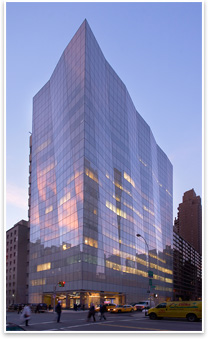The User’s Guide: Health Care: A Worse-Off Market, But Still One of the Best
After years of exceptional growth, the health-care design and construction market levels off, but still looks to be a winner
by Zach Mortice
Associate Editor
 How do you . . . find ways to take advantage of the relative stability of the health-care design and construction market? How do you . . . find ways to take advantage of the relative stability of the health-care design and construction market?
Summary: Although the commercial and residential sectors of the architecture industry have been rocked by the current economic crisis, the health-care architecture market is projected to remain stable. Its resistance to business downturns is a result of the high and increasing demand for health-care facilities, as well as its long-term planning and capital-gathering processes, which have insulated it from Wall Street credit woes. Although health-care architecture specializations take serious commitments of time and labor to develop, firms wanting to make inroads into this market can partner with more experienced firms and attempt smaller scale health-care projects.
See what the Academy of Architecture for Health Knowledge Community is up to.
Take a look at some of the 2008 AAH Healthcare Award winners.
Do you know SOLOSO?
The AIA’s resource knowledge base can connect you to “Healthcare 101: Programming,” a vide primer on the early stages of healthcare design directed at emerging healthcare architecture professionals.
See what else SOLOSO has to offer for your practice.
Considering its previous years of double-digit growth, now is hardly the best time for architects to start expanding their practices into the health-care architecture market. Nevertheless, industry experts, economists, and practitioners are all expecting it to happen.
Like all other sectors of the design and construction industry, economic forecasters are predicting the health-care market to be negatively affected by today’s current financial crisis. Its years and years of unprecedented growth won’t resume for quite some time, but, even so, the health-care market is still a relative rock of stability in the economy (unlike the residential and commercial construction sectors), guided by long-term planning and advance funding and less by the capricious lending tastes of creditors or the vagaries of Wall Street.
“I’d rather be in health care now than any other segment of the market,” says Joe Sprague, FAIA, the director of health facilities at HKS Inc. in Dallas. “When the market turns down, architects who chose not to be involved in health care during strong markets all of a sudden say: ‘That’s a good market. I think I’ll go into it.’”
Pining for flat growth
The latest AIA Consensus Construction Forecast report (released in July) predicts that the health-care design and construction industry will lay flat through 2008, with a modest increase in 2009. Meanwhile, the commercial market is expected to drop by 11 percent in 2009, and FMI (a construction industry management consultant and investment banking firm) predicts that residential development will have dropped by 26 percent in 2008 and another 7 percent in 2009. The most recent Architecture Billings Index report in October recorded the first downturn in four years in the institutional market, which is typically thought of as recession resistant and encompasses the health-care market.
Although the health-care market shouldn’t be expected to live up to any “recession proof” legend, the reasons for its durability exist beyond the basic and unwavering demand for health-care facilities in all places. This resilience is also the result of the long-term regulatory planning and advance funding required of health-care facilities. From conception to occupancy, the planning and construction process for a hospital can be five years or longer, says Peter Bardwell, FAIA, principal of Bardwell Associates in Columbus, Ohio. Funding is often gathered two years before construction and typically flows from hospital service payments and government supplements like Medicare payouts, which makes it less dependent on constricting credit.
“The projects for which capital is already committed or are already under way are going to play themselves out irrespective of the bottom falling out of the economy,” says Bardwell, whose firm focuses exclusively on health-care architecture and health-care planning.
But this means that future projects that are gathering funding now might be delayed or scaled down. “I think there’s more risk in the hospital market in 2010 than there is for 2009,” says Jim Haughey, chief economist at Reed Construction Data. “When there are troubles in the economy, it comes late to institutional projects like hospitals. They seem to be immune for a while and all of a sudden they slow down when everything else is starting to pick up again.”
The Back Story:
The Academy of Architecture for Health: A Good Place to Start
As a registered nurse and a principal at NBBJ in Seattle, Teri Olerich, Assoc. AIA, suggests looking to the AIA’s Academy of Architecture for Health (AAH) Knowledge Community for leads on how to find health-care design work. Its Web site and professional network can help architects find experienced firms to partner with, and can direct them to healthcare RFPs and RFQs.
Olerich, the 2009 president-elect of the AAH, also suggests talking to master planning firms, like KSA, that might hear of health-care work early in the development process. The government’s FedBizOps Web site is also a source of government-sponsored health-care work.
Even while looking for health-care work in an economic downturn, architects shouldn’t shy away from sustainability, Olerich says. Health-care administrators are more apt to appreciate the long-term efficiency benefits that come with more sustainable buildings because they tend to plan and think about their jobs as long-term stewardships. “The CEOs and COOs I work with always talk about their legacy,” she says.
But, Olerich says, the thing to remember is that no firm can be reinvented as health-care experts overnight, in either an economic downturn or upswing. “I hope firms don’t dabble in health care to get through the recession,” she says. “I hope it’s a commitment to education of their architects, a commitment to collaborating with other firms to do things correctly.”
 Further buffering the health-care architecture market is the rise in health facility demand caused by millions of Baby Boomers approaching age 60. Sprague (whose firm’s business is 60 percent health-care work) says long-established Sunbelt migration patterns are still fueling health-care construction growth across the South. Heather Jones, a construction economist with FMI, says the hotspots for health-care construction growth form a u-shape across the country, from the West coast, across the South, and as far north as the Mid-Atlantic on the East Coast. Decreases in growth, she says, will drop this u-shape along the East Coast, as health-care construction cools from Virginia to Florida. Conversely, Haughey says he expects large northern cities like Chicago, Philadelphia, and New York to generate significant health-care construction, primarily for renovation and replacement of old hospital facilities. In situations such as these, Haughey says, health-care construction is tied more to income levels than pure population growth. Additionally, state laws requiring California hospitals to be given seismic retrofits have made the state a hub of health-care construction activity, though much of this work has already been commissioned and assigned, Bardwell says. Further buffering the health-care architecture market is the rise in health facility demand caused by millions of Baby Boomers approaching age 60. Sprague (whose firm’s business is 60 percent health-care work) says long-established Sunbelt migration patterns are still fueling health-care construction growth across the South. Heather Jones, a construction economist with FMI, says the hotspots for health-care construction growth form a u-shape across the country, from the West coast, across the South, and as far north as the Mid-Atlantic on the East Coast. Decreases in growth, she says, will drop this u-shape along the East Coast, as health-care construction cools from Virginia to Florida. Conversely, Haughey says he expects large northern cities like Chicago, Philadelphia, and New York to generate significant health-care construction, primarily for renovation and replacement of old hospital facilities. In situations such as these, Haughey says, health-care construction is tied more to income levels than pure population growth. Additionally, state laws requiring California hospitals to be given seismic retrofits have made the state a hub of health-care construction activity, though much of this work has already been commissioned and assigned, Bardwell says.
 Who to know and what to do Who to know and what to do
Despite the health-care architecture market’s (relatively) rosy economic forecast, its complexity and specialization doesn’t make it an easy field to translate other practice experiences into. Health-care architects have to understand intricate regulatory environments and must be unmatched health, safety, and welfare experts; skills that aren’t emphasized to such an extreme level in the practice of the commercial or residential architects who have been hit hardest by the economic downturn.
But there are ways to make inroads into this segment of the architecture market. Bardwell (the current president of the Academy of Architecture for Health Knowledge Community) suggests taking on smaller primary care projects, like physicians offices. For commercial architects, it may only be a matter of following the private developers they already know as they look for health-care work to build. Less experienced health-care architects can also partner with established firms on projects, so the newcomers can learn health-care design terminology, its unique design process, and how to work with clinical personnel.
|


 How do you . . .
How do you . . .  Building Type Basics for Healthcare
Building Type Basics for Healthcare Further buffering the health-care architecture market is the rise in health facility demand caused by millions of Baby Boomers approaching age 60. Sprague (whose firm’s business is 60 percent health-care work) says long-established Sunbelt migration patterns are still fueling health-care construction growth across the South. Heather Jones, a construction economist with FMI, says the hotspots for health-care construction growth form a u-shape across the country, from the West coast, across the South, and as far north as the Mid-Atlantic on the East Coast. Decreases in growth, she says, will drop this u-shape along the East Coast, as health-care construction cools from Virginia to Florida. Conversely, Haughey says he expects large northern cities like Chicago, Philadelphia, and New York to generate significant health-care construction, primarily for renovation and replacement of old hospital facilities. In situations such as these, Haughey says, health-care construction is tied more to income levels than pure population growth. Additionally, state laws requiring California hospitals to be given seismic retrofits have made the state a hub of health-care construction activity, though much of this work has already been commissioned and assigned, Bardwell says.
Further buffering the health-care architecture market is the rise in health facility demand caused by millions of Baby Boomers approaching age 60. Sprague (whose firm’s business is 60 percent health-care work) says long-established Sunbelt migration patterns are still fueling health-care construction growth across the South. Heather Jones, a construction economist with FMI, says the hotspots for health-care construction growth form a u-shape across the country, from the West coast, across the South, and as far north as the Mid-Atlantic on the East Coast. Decreases in growth, she says, will drop this u-shape along the East Coast, as health-care construction cools from Virginia to Florida. Conversely, Haughey says he expects large northern cities like Chicago, Philadelphia, and New York to generate significant health-care construction, primarily for renovation and replacement of old hospital facilities. In situations such as these, Haughey says, health-care construction is tied more to income levels than pure population growth. Additionally, state laws requiring California hospitals to be given seismic retrofits have made the state a hub of health-care construction activity, though much of this work has already been commissioned and assigned, Bardwell says. Who to know and what to do
Who to know and what to do